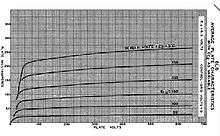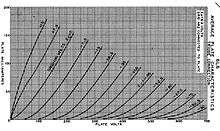6L6
6L6 is the designator for a vacuum tube introduced by Radio Corporation of America in July 1936. At the time Philips had already developed and patented power pentode designs, which were rapidly replacing power triodes due to their greater efficiency. The beam tetrode design of the 6L6 allowed RCA to circumvent Philips' pentode patent.
| 6L6 | |
|---|---|
 Pair of 6L6GC tubes: Left: General Electric version from 1960s Right: current manufacture from Svetlana Electron Devices | |
| Classification | Beam power tetrode |
| Service | Class-A amplifier, class-B amplifier, class-AB amplifier, (audio amplifiers) |
| Height | 4.25 in (108 mm) |
| Diameter | 1.438 in (36.5 mm) |
| Cathode | |
| Cathode type | Indirectly heated |
| Heater voltage | 6.3 |
| Heater current | 900 mA |
| Anode | |
| Max dissipation Watts | 30 |
| Max voltage | 500 Specification listed is for type 6L6-GC |
| Socket connections | |
 The 6L6 Pinout, metal versions had the shell connected to pin 1 Pin 1 – n.c | |
| Typical class-A amplifier operation | |
| Anode voltage | 350 V |
| Anode current | 54 mA |
| Screen voltage | 250 V |
| Bias voltage | −18 V |
| Anode resistance | 5 kOhms |
| Typical class-AB amplifier operation (Values are for two tubes) | |
| Power output | 55 W |
| Anode resistance: (anode to anode) | 5.6 kOhms |
| Anode voltage | 450 V |
| Anode current | 2*54 mA |
| Screen voltage | 400 V |
| Bias voltage | −37 V |
| References | |
| Essential Characteristics, General Electric, 1973 | |
History
The 6L6 is a descendant of the "Harries Valve" developed by British engineer J. Owen Harries and marketed by the Hivac Co. Ltd. in 1935. Harries is believed to have been the first engineer to discover the "critical distance" effect, which maximized the efficiency of a power tetrode, by positioning its anode at a distance which is a specific multiple of the screen grid-cathode distance. This design also minimized interference of secondary emission electrons dislodged from the anode.
EMI engineers Cabot Bull and Sidney Rodda improved the Harries design with a pair of beam plates, connected to the cathode, which directed the electron streams into two narrow areas and also acted like a suppressor grid to redirect some secondary electrons back to the anode. The beam tetrode design was also undertaken to avoid the patents which the giant Philips firm held on power pentodes in Europe. Because this overall design eliminated the "tetrode kink" (negative resistance) in the lower parts of the tetrode's voltage-current characteristic curves, which sometimes caused tetrode amplifiers to become unstable, MOV (Marconi-Osram Valve, a subsidiary of EMI jointly owned with General Electric Company Ltd) marketed this tube family under the sobriquet "KT", meaning "kinkless tetrode".
Because MOV's engineers did not feel the kinkless tetrode could be successfully mass-produced, they licensed the design to RCA. This proved to be a poor business decision on MOV's part. RCA subsequently had enormous success with the 6L6. It replaced the use of power triodes in public-address amplifiers almost overnight. So many applications were found for the 6L6 that a complete list would be impossible to assemble. MOV introduced their version, the KT66, a year later.

RCA's first version was an early octal base tube. Like most with this base it had a metal, rather than glass, envelope. Later versions, including the 6L6G, 6L6GA, 6L6GB, 5881, 5932, 7027, and the final version 6L6GC had glass envelopes, which made radiation cooling of the anode easier. The voltage and power rating of the 6L6 series were gradually pushed upwards by adding features such as a Micanol base, thicker plates, thicker grid wires, grid cooling fins, and special ultra-black plate coatings. The original metal version was rated for 19 watts dissipation while the later 6L6GC is usually rated for 30 watts. A "W" in the descriptor, as in 6L6WGB, identifies the tube as designed for mechanically rugged environments, such as military or airborne use.
Variations
Early variations included transmitting tubes such as the 807 (1937) with 6.3V heater, plate (anode) connected to a top cap, and equivalent 12.6V 1625, the smaller 6V6 (1936), the many KT versions marketed in Europe, and a subsequent vast array of audio and RF power tubes. One of the largest-volume post-WWII applications was in the basic design of television sweep power tubes, starting with the 6BG6G (1946), a modified 807. TV designs rarely used transistors in place of sweep tubes—a challenging high-power and high-speed application—until the 1970s.
The 807 was preferred to the similar 6L6 by amateur radio enthusiasts because high transient voltages on the 6L6's anode when operating in class C could cause a flashover between pins 2 and 3 on the octal base, whereas this was not a problem with the top-cap anode of the otherwise identical 807, physically distant from all the base pins.
In guitar amplifiers, this flashover problem sometimes occurs if the amplifier is operated without the speakers connected, causing the self inductance of the output transformer primary winding to generate high voltages when the current changes due to the applied signal. For this reason the speaker terminals of 6L6 tube amplifiers are sometimes short-circuited by a switching 6.3 mm jack when the speakers are disconnected.
Further testimony for this device's success would be even simpler: as of 2012 the 6L6GC version was still being manufactured and used, primarily in guitar amplifiers. Manufacture continued in Russia (two factories), China (two factories), and Slovakia. (In 2006, Ei Electronics in Serbia discontinued making tubes.) The 6L6 has had one of the longest active lifetimes of any electronic component, more than 70 years.
Characteristics
 Anode characteristics with grid 2 voltage as parameter
Anode characteristics with grid 2 voltage as parameter Anode characteristics with grid 2 connected to the anode (i.e. used as a triode)
Anode characteristics with grid 2 connected to the anode (i.e. used as a triode)
Replacement
- 5881
Similar tubes
- 6P3S (6П3С)
- 6P3S-E (6П3С-E)
- 7027a
References
- Stokes, John (1982). 70 years of radio tubes and valves. NY: Vestal Press. pp. 71–72.
- Thrower, Keith (1982). History of the British radio valve to 1940. MMA International. p. 59.
- Barbour, Eric (1996). "History of the 6L6". Vacuum Tube Valley (4): 3.
- Schade, O. H. (February 1938). "Beam Power Tubes". Proceedings of the IRE. 26 (2): 137. doi:10.1109/JRPROC.1938.228286.
External links
- TDSL Tube data [6L6]
- Electron Tube Data sheets: Several 6L6 datasheets from various manufacturers
- Kurt Prange. "6L6GC Comparison of Current Made Tubes" (PDF) (PDF). Archived from the original (PDF) on 2014-02-21. Retrieved 2014-02-16.
- Reviews of 6L6 tubes